Allegheny College
Allegheny College is a private liberal arts college in Meadville, Pennsylvania.[6] Founded in 1815, Allegheny is the oldest college in continuous existence under the same name west of the Allegheny Mountains.[7] It is a member of the Great Lakes Colleges Association and the Presidents' Athletic Conference, and it is accredited by the Middle States Commission on Higher Education.
 | |
| Motto | Greek: Πιστει την αρετιν εν δε τηι αρετιν την γνωσειν Hebrew: תגל ערבה ותפרח כחבצלת |
|---|---|
Motto in English | "Add to your faith, virtue and to your faith, knowledge" (2 Peter 1:5) "The desert shall rejoice and the blossom as the rose" (Isaiah 35:1) |
| Type | Private liberal arts college |
| Established | 1815 |
| Accreditation | MSCHE |
Academic affiliations | GLCA Annapolis Group |
| Endowment | $264 million (2022)[1] |
| President | Ron Cole[2] |
Academic staff | 193 (2018)[3] |
| Students | 1,442 (2022)[4] |
| Location | , , United States |
| Campus | Small town, 542 acres (219 ha) total |
| Colors | Blue & gold |
| Nickname | Gators |
Sporting affiliations | NCAA Division III – PAC |
| Mascot | Chompers |
| Website | allegheny |
 | |
| Designated | November 19, 1946[5] |
History
Pre-colonial history
The area where Allegheny College stands was the ancestral land of the Eriechronon people until the Iroquois Confederacy forced them out.[8] Having been displaced from their ancestral lands in what is now Eastern Pennsylvania, the Lenape or Delaware Tribe moved into the now unoccupied region. They formed an alliance with the neighboring Seneca, one of the five tribes that made up the Iroquois Confederacy, and other displaced Lenape. Under the leadership of Chief Custalog, they founded the settlement of Cussewago.[9][10][11] This settlement would later be abandoned and claimed by David Mead to become Meadville, Pennsylvania, on May 12, 1788.
Early history
Allegheny College was founded in April 1815[12][13] by the Reverend Timothy Alden, a graduate of Harvard's School of Divinity. The college has been affiliated with the United Methodist Church since 1833 but does not integrate religion into the classroom or pedagogy.

The first class, consisting of four male students, began their studies on July 4, 1816, without any formal academic buildings. Within six years, Alden accumulated sufficient funds to begin building a campus. The first building erected, the library, was designed by Alden himself, and is a notable example of early American architecture. Bentley Hall is named in honor of Dr. William Bentley, who donated his private library to the college, a collection of considerable value and significance. In 1824, Thomas Jefferson wrote to Alden, expressing the hope that his University of Virginia could someday possess the richness of Allegheny's library.[14] Alden served as president of the college until 1831 when financial and enrollment difficulties forced his resignation. Ruter Hall was built in 1853.[15]
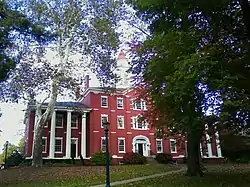
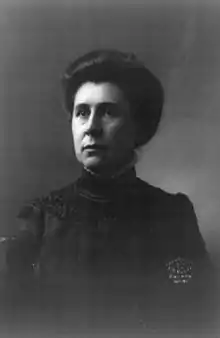
Allegheny began admitting women in 1870,[16] early for a US college; a woman was valedictorian of the Allegheny class of 1875.[16] By the time Ida Tarbell, future journalist, arrived in 1876, nineteen women had attended Allegheny and only two had graduated. Tarbell described Ruter Hall in her writing, "...looking out on the town in the valley, its roofs and towers half hidden by a wealth of trees, and beyond it to a circle of round-breasted hills. Before I left Allegheny I had found a very precious thing in that severe room--the companionship there is in the silent presence of books."[17]

In 1905, Allegheny built Alden Hall as a new and improved preparatory school.[12] Over the decades, the college has grown in size and significance while still maintaining ties to the community.
Recent history
In 1971 the film Been Down So Long It Looks Like Up to Me based on the Richard Farina novel was filmed on college grounds.[18][19]
While the word "Allegheny" is a brand for the college, it is also the name of a county, a river, and a mountain range, and the school has tried to prevent other entities from using this word. For example, Allegheny objected in 2006 when Penn State tried to rename one of its campuses "Allegheny".[20][21] Allegheny president Richard Cook said 'Allegheny' was "our brand."[20] It sued the Philadelphia's Allegheny Health and Research Foundation in 1997 to change its name.[22]
Under president Richard J. Cook, Allegheny was reported to have had a "stronger endowment, optimal enrollment, record retention rates, innovative new programs and many physical campus improvements."[23] These years were marked by significant growth in the endowment, marked by a $115-million fund-raising drive, bringing the endowment to $150 million.[24][25] In February 2008, James H. Mullen Jr. was named the 21st president of Allegheny. He took office on August 1, 2008.[26]
The college and the town cooperate in many ways. One study suggested the Allegheny College generates approximately $93 million annually into Meadville and the local economy.[27] Since 2002, Allegheny hosts classical music festivals during the summer.[28] In October 2006, the college attracted negative publicity after local enforcement cited over 100 people for underage drinking at a college party.[29] In July 2007, a 1,500-pound wrecking ball demolishing part of Allegheny's Pelletier Library broke its chain, rumbled down the hill, careened "back and forth across the street," hit nine parked cars, wrecked curbs, and crashed into the trunk of an Allegheny student's car, pushing his car into two cars in front of him.[30][31] Eight soccer balls in his car "likely lessened the impact of the wrecking ball," and possibly spared his life, according to a police officer on the scene.[30][32] The student body voted to name the library's coffee shop "The Wrecking Ball" after the event.
The college has sponsored panels on unusual topics such as face transplants (2009).[33] Allegheny professors have joined highly visible initiatives; for example, Allegheny professor Michael Maniates, described as the "nation's leading authority on the politics of consumption," joined the board of a project about the twenty-minute film The Story of Stuff by filmmaker Annie Leonard, and generated headlines.[34] Dr. Maniates said, "We really need to think of ways of making it possible for people to think about working less and getting by on less."[35] At present, environmental concerns are important at Allegheny, which in 2008 worked with Siemens to devise a "total energy use reduction plan" for the college.[36]
Campus
The campus has 40 principal buildings on a 79-acre (32 ha) central campus located just north of downtown Meadville, a 203-acre (0.82 km2) outdoor recreational complex north of campus, called the Robertson Athletic Complex, and the 283-acre (115 ha) Bousson nature reserve, protected forest, and experimental forest.[37]
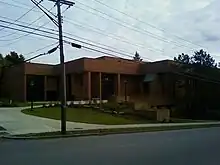
Academic buildings
- Alden Hall
- Arnold Hall of Music
- Arter Hall
- Carnegie Hall
- Carr Hall
- Doane Hall (Art)
- Doane Hall of Chemistry
- Montgomery
- Murray Hall
- Oddfellows
- Quigley Hall
- Ruter Hall
- Steffee Hall of Life Sciences
- Vukovich Center for Communication Arts features a garden roof for energy efficiency and beauty. It was completed in 2008 at a cost of $23 million.[38][39] Robert Vukovich (1965) and Laura Vukovich made a substantial donation of $22 million in February 2001, part of which was used to construct the building.[39][40] Allegheny has its own cable TV channels and a state-of-the-art television studio.[6]
Residence halls
- Allegheny Commons is located about a 5-minute walk from campus and features 2 or 4 person air-conditioned apartments with full kitchens.[41]
- Baldwin Hall is one of three all-first-year halls, houses almost 200 students in double rooms.
- Brooks Hall, in addition to being one of the main dining halls, also houses female residents in 1, 2, or 4 person rooms.[41]
- College Court is located at the southern part of the campus and houses 77 students in apartment style units which share a common courtyard and feature a kitchen and air conditioning.[41]
- Crawford Hall located across from the Henderson Campus Center, is community style and houses all women.
- Edwards Hall (officially Edwards House) is located near the Murray Hall and houses co-ed all first-years in double rooms.
- Hullings Hall is one of the oldest parts of the campus; it constitutes part of Brooks Hall.[16]
- North Village houses 110 residents in air-conditioned suites with 5 residents per suite. The most environmentally friendly of all the residence halls, it features geothermal heating, eco-friendly tiles, and rainwater recharge stations[41]
- North Village II is the newest residence hall on campus, which houses 230 residents in either quad or double living in an air-conditioned quarters.[41]
- The Phi Kappa Psi fraternity house houses members of the Phi Kappa Psi fraternity.
- Ravine-Narvik Hall was built in 1970, and houses students in pods containing 4 double rooms with a shared bathroom. Located near the edge of campus, this dorm houses both male and female students.[41]
- Schultz Hall (formerly South Hall) houses first-year students in double rooms. Located on the southern part of campus, this building also houses the Winslow Health Center.[41]
- Delta Tau Delta’s fraternity shelter was formerly known as South Highland Hall and houses members of the Delta Tau Delta fraternity.
- Walker Hall and Walker-Annex Hall are adjacent and connected to Brooks Hall and house both male and female students in singles or doubles. The buildings feature recently renovated lounges which include kitchens.[41]
Non-residential buildings
- The Pelletier Library (in 2008) had 922,540 volumes (491,284 microform titles).[42] Another estimate was that the library had 420,000 bound volumes, 227,000 microform titles, 1,000 periodicals, and 261,000 U.S. government and Pennsylvania state documents.[6] The library has noteworthy Americana and Ida Tarbell collections,[6] as well as materials concerning abolitionist John Brown's years in Crawford County.[43] computer lab, audiovisual center, and music listening system are there too.[6] It is named after past president Lawrence L. Pelletier who served from 1955 to 1980.[44] The Learning Commons, which is located in Pelletier Library, assists students with writing, research, public speaking and study skills, and also offers disability services.
- Newton Observatory houses a nine-inch refracting telescope and a computer-interfaced 10-inch Meade LX200 telescope with CCD camera. The Office of Public Safety and Security is also housed in the Newton Observatory.[45]
- The Allegheny College Center for Experiential Learning (ACCEL) coordinates career internships, off-campus study programs, service-learning, pre-professional advising, and leadership development.[42]
- A Counseling Center, which has joined the Winslow Health Center in Schultz Hall, offers guidance for students in adjusting to student life. The center is staffed by registered therapists and provides crisis and walk in hours to students, free of charge.[42]
- Winslow Health Center is staffed by a registered nurse and offers routine diagnosis and treatment. The center also offers free STI testing to students on a monthly basis.[42]
 Brooks Hall, autumn 2009.
Brooks Hall, autumn 2009. - The main dining facility is in Brooks Hall, and students can also dine at McKinley's Food Court in the campus center. There have been efforts by students to support the relationship between food services and local farmers.[46] Allegheny won a $79,545 grant in May 2009 to buy equipment to help with composting food waste, including a shredder mill, screening plant, conveyor, skid-steer loader and leaf collection system.[47]
- The Center for Political Participation was founded at Allegheny in 2002 by political science professor Daniel M. Shea, following concerns about low youth voter turnout in the 2000 presidential election.[48] The CPP conducts scholarly research related to youth political participation; sponsors on-campus events related to politics and the electoral process, such as panel discussions; and conducts community-outreach efforts, including the Model Campaign USA program, a campaign simulation designed to get high school students interested in electoral politics.
- Henderson Campus Center was recently renovated and includes McKinley's food court, the bookstore, the game room, Grounds for Change—the student-run coffee house, the post office, and campus offices of college departments as well as student organizations.[49] Also included in the Henderson Campus Center are the Bowman, Penelac & Megahan Art Galleries.[6] Allegheny has auctioned art at times to raise money to renovate other projects, such as the college's Doane School of Art.[50]
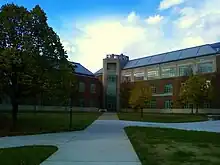
- Sports facilities include the $13 million David V. Wise Sport & Fitness Center, which opened in 1997.[6]
- A Women's Center which is located in the basement of Walker Hall was established in 2003 to be a resource for research on gender issues and women's history.[51]
- The college established the Center for Economic and Environmental Development in 1997.[52]
Academics
Allegheny College's majors and minors fall into three spheres: Humanities, Natural Sciences, and Social Sciences. There are some majors, such as Environmental Studies or International Studies, which fall into the interdisciplinary category. The college requires students to choose a minor as well as a major[53] and encourages "unusual combinations" of majors and minors.[53] A student's major can be in the humanities, social sciences or natural sciences, but that student's minor must be in a different division than their major.[54][53]
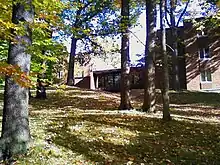
Allegheny is accredited by the Middle States Commission on Higher Education (MSCHE).[13]
About 30% of the college's 2,100 students graduate in one of the STEM disciplines—science, technology, engineering, and math.[54] Students must take at least two courses (8 semester credit hours) in a discipline other than their major or minor.[55]
The most popular majors, in terms of 2021 graduates, were:[56]
- Biology/Biological Sciences (35)
- Psychology (34)
- Environmental Science (33)
- Economics (27)
- Neuroscience (20)
- English Language and Literature (20)
- International Public Health/International Health (20)
- Political Science and Government (20)
Total credits for graduation are 128 semester credit hours and no more than 64 credit hours can be from any one department.[55] Almost all courses carry four semester hours of credit.[57]
The college requires all students to take a three-seminar series which "encourages careful listening and reading, thoughtful speaking and writing, and reflective academic planning and self-exploration," to be completed in their first two years.[58] Sophomores typically meet with faculty advisers eight times a year.[59]
Allegheny requires seniors to complete a senior project in their major.[55] Some senior projects can be quite ambitious; in 2007, one senior project involved comprehensive instructions for installing solar panels on the roof of a campus building.[60]
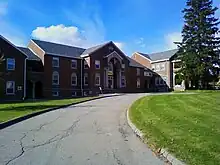
Allegheny divides its academic calendar into two 15-week semesters. The school year typically runs from the last week of August to mid-May, with a short fall break in mid-October, a Wednesday-to-Sunday Thanksgiving break, a month-long winter break from mid-December to mid-January, and a week-long spring break in the third week of March.[61]
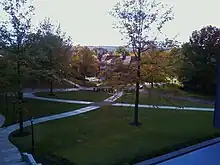
It formerly had a Chinese language minor, which was discontinued with the Chinese program itself in 2022.[62]
Study abroad
Allegheny offers direct enrollment programs at Lancaster University, England; James Cook University, Australia; University of Natal, South Africa; Capital Normal University, China; and Karl-Eberhard University, Germany.[6] It also offers language and area studies programs in Seville, Spain; Angers, France; Karls-Eberhard University, Germany; and Querétaro, Mexico[6] and internship programs in London, England; Paris, France; and Washington D.C.[6] Programs geared to specific majors are also available, including environmental studies at the Arava Institute for Environmental Studies, Israel; and the Center for Sustainable Development, Costa Rica; marine biology at the Duke University Marine Lab in North Carolina; and political science at American University.[6] Allegheny faculty members have led domestic summer-study tours to New York, Yellowstone, Austria, Costa Rica, and South Africa.[6] Individually arranged study abroad has taken students to Argentina, Canada (Nova Scotia), China, Cuba, Greece, Italy, Mexico, and Scotland.[6]
Cooperative and reciprocal programs
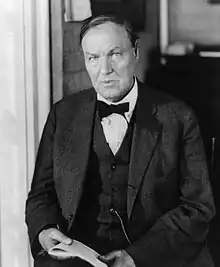
Allegheny has medical school cooperative programs available with three institutions: Philadelphia College of Osteopathic Medicine, Drexel University[63] and Jefferson Medical College. Allegheny offers pre-professional programs in law and health.[42] It has an arrangement with Drexel University College of Medicine to admit two Allegheny students who meet specific criteria (grades, MCAT scores).[42] It has an arrangement with the William E. Simon School of Business Administration at the University of Rochester to have preferred admission to selected students by the end of their junior year.[42][59] Allegheny offers cooperative 3–2 liberal arts/professional programs in engineering with Case Western Reserve University, Columbia University, the University of Pittsburgh, and Washington University in St. Louis.[6] There is also a 3–2 Master of Information Systems Management (MISM) program reciprocal agreement with Carnegie Mellon University.
Faculty
Four faculty won Fulbright Awards in March 2001.[64] Faculty sometimes focus on the local area; for example, economics professor Stephen Onyeiwu conducted a study of manufacturing in the northwestern Pennsylvania region.[65] Ninety percent of faculty have terminal degrees in their respective fields.[6] Books by faculty include Congressional Women and Comedy from Shakespeare to Sheridan.[6] Faculty actively publish on a wide range of subjects from the biology of woodpeckers,[66] to structural features of ribosomal RNA,[67] to freshwater invertebrates.[68] In 2018, Professor Shannan Mattiace won a Fulbright Award to teach and conduct research in Chile.[69]
Admissions
There were 5,479 applications for admission to the class of 2022 (enrolling fall 2018): 3,485 were admitted (63.6%) and 474 enrolled (an admissions yield of 13.6%).[70] The average high school GPA of enrolled freshmen was 3.51, and 35% had a high school GPA of 3.75 or higher.[70] The middle 50% range of enrolled freshmen on SAT scores was 560–680 for reading and writing, and 560-660 for math, while the ACT Composite middle 50% range was 24–30.[70]
Rankings
| Academic rankings | |
|---|---|
| Liberal arts colleges | |
| U.S. News & World Report[71] | 76 |
| Washington Monthly[72] | 42 |
| National | |
| Forbes[73] | 403 |
| THE / WSJ[74] | 164 |
Times Higher Education World University Rankings ranked Allegheny 60th among the top 100 U.S. liberal arts colleges for 2022.[75]
U.S. News & World Report ranked Allegheny as tied for 76th among liberal arts colleges, 25th for "Best Undergraduate Teaching," tied for 38th in "Top Performers for Social Mobility", and 42nd in "Best Value Schools" in the United States for 2022.[76]
Washington Monthly, which rates schools based on the degree to which they "contribute to the public good" by improving social mobility, producing research, and promoting service, ranked Allegheny 42nd among 203 liberal arts colleges in 2022.[77]
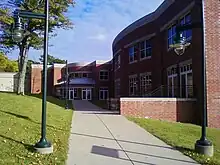
Student life
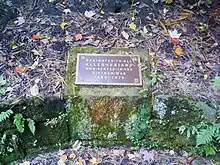
Students
Students generally are required to live on campus for all four years, and may reside in traditional dormitories, apartment-style housing, or college-owned houses.[37]
The demographics of students as of fall 2015 were: White (non-Hispanic) 75.9%; Hispanic/Latino 7.0%, Black (non-Hispanic) 5.9%; Two or more races 4.7%, Non-resident alien 2.8%, Asian & Pacific Islander 2.4%; American Indian or Alaskan native 0.1%; Unknown 1.2% .[4]
Allegheny students in 2008 come from 33 states and 25 other countries.[6] Allegheny had a "diversity index" of .15 on a scale of .99=extremely diverse to .01=not diverse.[78]
Students participate in volunteer activities: in the fall semester of 2011, the student body contributed 25,000 hours of volunteer service to the community.[79] Some Allegheny students volunteered to help restore businesses in hurricane-ravished New Orleans.[80] Residence halls and classrooms are closed during summers.[42] An Allegheny Student Government has an active role in formulating college policy, curriculum choices, personal conduct, promoting cultural programs, and making decisions about the school's calendar.[6]
Information about students is generally kept private in keeping with the 1974 "Family Educational Rights and Privacy Act" which prohibits colleges from releasing information about their students without student permission.[81] Accordingly, parents can not learn about their son's or daughter's grades unless a waiver is signed permitting release of such information. The privacy policy can sometimes lead to problems, particularly when students have mental health problems but the school is prevented legally from contacting parents. In 2002, one Allegheny student committed suicide, and his parents sued the school; a jury in 2006 found that the school was not liable or negligent.[81] This case helped focus national attention on the competing issues of student privacy and parental rights.[82]
Campus security includes 24-hour foot and vehicle patrols, late night escort service, lighted pathways and sidewalks, controlled residence hall access, and 24-hour emergency telephones.[83] Health service is offered.[83] Despite proximity to the snowbelt, snow rarely shuts down the town of Meadville or the college.[84]
Official college policy is to discourage underage (less than 21 years) drinking, although there have been incidents of violations at off-campus parties.[85] Incoming students are required to take an online course about the dangers of alcohol abuse.[85] The school punishes transgressions with disciplinary action.[85]
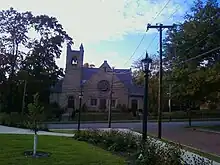
Media
Students run a campus radio station WARC 90.3 FM and a publication called "The Allegheny Review" of undergraduate literature.[86] The college hosts outside speakers.[87] Allegheny has numerous student groups and organizations such as an astronomy club, a College Choir, an Outing Club, and a Peace Coalition.[88] There are over 100 clubs and organizations offered at Allegheny.[6] The Allegheny newspaper is called The Campus. It is distributed weekly at locations all over the college. It covers campus news, features, opinion and a wrap-up of the college sports. The Campus is entirely student-run, with an editorial board of students in charge of making all executive decisions for the publication. The Allegheny alternative magazine is called Overkill. It is tri-semester student publication distributed in unconventional locations around campus, such as in vending machines, fireplaces, and chandeliers. It features student editorials, poetry, non-fiction and fiction pieces, art, and photography with a highly distinctive design and attitude.
Allegheny has welcomed a variety of entertainers and guest speakers over the last several years including John Updike, Dave Matthews, Dick Cheney,[89] Bill Clinton,[90] W.D. Snodgrass, Adam Sandler, George Carlin, The Vienna Choir Boys, Rusted Root, Ben Folds, The Roots, Stephen Lynch, The Fray, Jimmy Fallon,[91] and comedian Wayne Brady.[92] There have been "live" art shows in which invited artists, over an eight-hour period, created 10-by-10-foot "drawings" on gallery walls while spectators watched.[93]
Athletics

| Sports |
|---|
| Men's |
|
NCAA Division III Lacrosse, Cross-Country Running, Football, Basketball, Swimming and Diving, Track and Field, Baseball, Golf, Soccer, Tennis |
|
Intercollegiate Club Teams Cheerleading, Crew, ESports, Equestrian Sports, Fencing, Table Tennis, Ice Hockey, Skiing (Downhill), Ultimate Frisbee, Rugby, Lacrosse, Volleyball |
| Intramurals |
| Women's |
|
NCAA Division III Cross-Country Running, Basketball, Swimming And Diving, Track And Field, Softball, Golf, Lacrosse, Soccer, Tennis, Volleyball |
|
Intercollegiate Club Teams Cheerleading, Crew, Equestrian Sports, Fencing, Table Tennis, Skiing (Downhill), Ultimate Frisbee, Rugby |
|
Intramural Sports Bowling, Football, Racquetball, Basketball, Softball, Golf, Soccer, Tennis, Volleyball |
Allegheny, known athletically as the Gators, belongs to the Presidents' Athletic Conference (PAC) and has NCAA Division III teams.[94] The Gators returned to the PAC in 2022 after a 38-year absence spent in the North Coast Athletic Conference (NCAC); the field hockey team remains in the NCAC because the PAC does not sponsor that sport.[95]Men's sports are baseball,[96] basketball,[97][98] cross country, football,[99] golf, soccer,[100] swimming and diving, tennis,[101] and track & field.[94][102][103] Women's sports are basketball,[97][98] cross country, golf, lacrosse, soccer,[100] softball, swimming & diving, tennis,[101] track & field,[103] and volleyball.[94] Sports facilities include the Wise Center and the Robertson Complex.[104] 75 percent of students play intramural sports.[6]
Branch Rickey was Allegheny College Athletic Director from 1904 to 1905, and coached baseball, basketball, and football. Rickey also served as instructor of Shakespeare, English, and History.
The 1990 Allegheny football team, led by first-year head coach Ken O'Keefe, won the Division III football national championship with a 13–0–1 record and a 21–14 victory over Lycoming in the Stagg Bowl.[105]
Green Initiatives
Allegheny College has undertaken several projects to become more a sustainable campus. One such project is the October Energy Challenge,[106] in which students are encouraged to save electricity for a one-month period. The difference in cost between that month and the previous month's electrical power is then reinvested back into sustainable campus infrastructure. Previous energy challenge have resulted in the addition of water-bottle stations to encourage use of reusable water bottles and solar panels on the biology building.
Other projects include the Carrden, a student-lead garden that grows organic produce, multiple rain gardens, a green box program for reusable takeout containers, as well as the college itself becoming the first college in Pennsylvania to achieve Carbon Net-Neutrality [107]
There are multiple student groups dedicated to environmental protection including SEA (Students for Environmental Action), AC Food Rescue, and Creek connections.[108]
Traditions
One tradition is that a female student is not a "real co-ed" until she's been kissed on the thirteenth plank of the Rustic bridge over the stream.[109][110] Legend states that there is a competition among residence halls during Orientation Week to steal the thirteenth plank and display it, though this rarely happens today;[111] random students take the plank instead, with maintenance keeping a supply of replacement planks on hand.[109]
Fraternities and sororities
Allegheny College also has a number of fraternities and sororities on campus. These include Kappa Kappa Gamma, Kappa Alpha Theta, Delta Delta Delta, Alpha Delta Pi, and Alpha Chi Omega for the sororities. In 2009, 34% of Allegheny women belonged to a sorority.[112] The fraternities on campus include Theta Chi, Phi Kappa Psi, Delta Tau Delta, Phi Delta Theta, Phi Gamma Delta and Phi Beta Sigma. In the Fall of 2016, the Nu Mu chapter of Phi Beta Sigma was reactivated at Allegheny College. The Sigma Alpha Epsilon fraternity was suspended in July 2013.[113]
Administration
Location and transportation
Allegheny is located in northwestern Pennsylvania 90 miles (140 km) north of Pittsburgh, 90 miles (140 km) east of Cleveland, and 35 miles (56 km) south of Erie, in the town of Meadville, Pennsylvania.[6] The school's main address is 520 North Main Street, Meadville, PA 16335.[6] The phone number is (814) 332–3100.[6] Allegheny is located near Interstate 79.
Administration and staff
The acting president since September 2022 is Ron Cole, the college's former provost and Dean of college. There are approximately 150 administration and staff personnel in 2008.[42] The staff breakdown is as follows: 157 full-time employees doing instruction, research, and public service; 43 executive, administrative, and managerial personnel; 103 other professionals (support/service); 9 technical and paraprofessionals; 68 clerical and secretarial employees; 12 skilled craftspersons; and 27 service & maintenance staff.[114] In addition, part-time staff included 36 instructors, 23 other professionals, 10 secretaries, and 4 service and maintenance staff.[114] Of the 157 full-time faculty, 87 have tenure, and 41 are on a tenure track.[114] The average salaries of professors (in 2007) was $83K, associate professors was $63K, assistant professors was $51K, instructors was $38K.[114] Allegheny is a member of the Higher Education Data Sharing Consortium, or HEDS, in which member institutions share information relating to improvement of higher education.[115]
Notable people
References
- As of March 7, 2022. U.S. and Canadian Institutions Listed by Fiscal Year 2021 Endowment Market Value and Change in Endowment Market Value from FY20 to FY21 (Report). National Association of College and University Business Officers and TIAA. 2022. Retrieved June 5, 2023.
- "Link leaving Allegheny College; Cole named acting president". Meadville Tribune. Retrieved September 20, 2022.
- "Common Data Set 2018–2019, Part I". Allegheny College Institutional Research. Archived from the original on October 1, 2019. Retrieved October 1, 2019.
- "Common Data Set" (PDF). Allegheny College Institutional Research. Archived (PDF) from the original on April 10, 2022. Retrieved May 26, 2022.
- "PHMC Historical Markers Search" (Searchable database). Pennsylvania Historical and Museum Commission. Commonwealth of Pennsylvania. Archived from the original on March 21, 2016. Retrieved January 25, 2014.
- "Allegheny College". FastWeb. August 28, 2009. Archived from the original on May 17, 2006. Retrieved August 28, 2009.
- "Allegheny College". Archived from the original on May 8, 2013. Retrieved May 19, 2013.
- "No Connections Available". Catalog. The library of Congress. Archived from the original on November 4, 2021. Retrieved November 4, 2021.
- Washington, George (1754). "The Journal of Major George Washington". Digital Commons. University of Nebraska-Lincoln. Archived from the original on March 4, 2009. Retrieved November 3, 2021.
- Washington, George (1753–1754). "Washington's 2 Journals 1753-1754". French and Indian War Foundation. Archived from the original on November 4, 2021. Retrieved November 3, 2021.
- Costa, Brenda. "Rich Cultural History". French Creek Valley Conservancy. Archived from the original on November 4, 2021. Retrieved November 3, 2021.
- Stewart, Anne W. (February 7, 2003). "Nothing New Under the Sun". The Wall Street Journal. Archived from the original on December 23, 2015. Retrieved August 26, 2009.
- "Allegheny College". 4International Colleges & Universities. August 28, 2009. Archived from the original on November 27, 2009. Retrieved August 28, 2009.
- Haskins, Charles H.; Hull, William I. (1902). A History of Education in Pennsylvania. Washington Government Printing Office. p. 10. Archived from the original on June 27, 2014. Retrieved March 16, 2016.
- "National Historic Landmarks & National Register of Historic Places in Pennsylvania". CRGIS: Cultural Resources Geographic Information System. Archived from the original (Searchable database) on July 21, 2007. Retrieved August 19, 2012. Note: This includes Davis, John P. (December 1977). "National Register of Historic Places Inventory Nomination Form: Ruter Hall" (PDF). Archived from the original (PDF) on December 5, 2014. Retrieved June 23, 2013.
- "Hulings Hall". Council of Independent Colleges. August 28, 2009. Archived from the original on July 24, 2011. Retrieved August 28, 2009.
- Weinberg, Steve (2008). Taking on the trust : the epic battle of Ida Tarbell and John D. Rockefeller. New York: W.W. Norton. pp. 89. ISBN 9780393049350. OCLC 154706823.
- "Been Down So Long It Looks Like Up to Me". The Internet Movie Database. 1971. Retrieved August 28, 2009.
- Budofsky, Laura (November 4, 1971). "C.U. Too Freaky for 50's Flick". Cornell Daily Sun. Vol. 87, no. 46. p. 1.
- Schackner, Bill (October 4, 2006). "Allegheny College opposes Penn State's renaming McKeesport campus". Pittsburgh Post-Gazette. Archived from the original on September 4, 2008. Retrieved August 25, 2009.
- Belser, Ann (October 12, 2006). "Penn State Ice Cream frozen out". Pittsburgh Post-Gazette. Retrieved August 25, 2009.
- "Fighting for a name: Allegheny College sues AHERF over health school moniker". Modern Healthcare. March 3, 1997. Retrieved August 28, 2009.
- Sostek, Anya (December 4, 2008). "Economy not hurting local college enrollment". Pittsburgh Post-Gazette. Retrieved August 25, 2009.
- "Elms College president named to lead Allegheny College". Boston Globe. Associated Press. February 20, 2008. Retrieved August 28, 2009.
- "Allegheny College surpasses goal". Pittsburgh Business Times. July 20, 2006. Archived from the original on October 25, 2012. Retrieved August 28, 2009.
- Chute, Eleanor (February 21, 2008). "Allegheny College names new president". Pittsburgh Post-Gazette. Archived from the original on October 20, 2012. Retrieved August 25, 2009.
- Hahn, Tim (June 6, 2007). "'Big, big asset': Study details college's benefit to economy". Crawford County News. Archived from the original on June 6, 2011. Retrieved August 26, 2009.
- "Allegheny College Revives Festival". Pittsburgh Post-Gazette. April 21, 2002. Archived from the original on May 29, 2022. Retrieved August 28, 2009.
- "Dozens face party-related charges". The Meadville Tribune. October 2, 2006. Archived from the original on January 28, 2013. Retrieved February 9, 2009.
- Levin, Steve (July 10, 2007). "Meadville mishap defines wrecking ball: One breaks loose, goes on tear near college". Pittsburgh Post-Gazette. Archived from the original on March 10, 2009. Retrieved August 25, 2009.
- Go, Alison (July 11, 2007). "Wreck and Roll". U.S. News & World Report. Archived from the original on February 5, 2013. Retrieved August 26, 2009.
- "Wrecking ball rampage in Meadville injures three". Pittsburgh Post-Gazette. July 9, 2007. Archived from the original on December 4, 2008. Retrieved August 25, 2009.
- "Allegheny College to host panel on face transplants". Pittsburgh Post-Gazette. May 20, 2009. Archived from the original on July 31, 2022. Retrieved August 26, 2009 – via USA Today.
- "Allegheny College Professor Michael Maniates Appointed to Story of Stuff Project…". Reuters. May 11, 2009. Archived from the original on February 1, 2013. Retrieved August 26, 2009.
- Johnson, Reed (May 10, 2009). "Shoppers cut back on spending, for now". The Los Angeles Times. Archived from the original on July 31, 2022. Retrieved August 28, 2009.
- "Siemens Helps Allegheny College Launch Energy Reduction Program". Reuters. June 17, 2008. Archived from the original on February 1, 2013. Retrieved August 26, 2009.
- "About Allegheny: Facts". Allegheny College.
- Bartlett, John (August 31, 2006). "Allegheny sets groundbreaking for $23M facility". Erie Times-News. Archived from the original on June 7, 2011. Retrieved August 26, 2009.
- "The Cook Years: A Timeline of Accomplishments and Events". Allegheny Magazine. February 2001. Archived from the original on May 28, 2010. Retrieved August 28, 2009.
- "Allegheny College gets $22.2 million gift". Pittsburgh Post-Gazette. February 16, 2001. Archived from the original on April 2, 2016. Retrieved August 28, 2009.
- "Residence Hall Information " Residence Life | Allegheny College - Meadville, PA". sites.allegheny.edu. Archived from the original on May 16, 2018. Retrieved May 16, 2018.
- "2008–2009 catalogue see various pages". Allegheny College. August 26, 2009.
- John Brown Memorial Association, Papers, 1826–1958, Pelletier Library, Allegheny College, OCLC 44935229
- Jones, Lamont (August 12, 1995). "Lawrence L. Pelletier – Allegheny College chief in 1955–80". Pittsburgh Post-Gazette. Retrieved September 2, 2009.
- "Physics: Facilities and Strengths". Allegheny College. Archived from the original on September 23, 2012. Retrieved May 20, 2013.
- Geisler, Jennie (May 5, 2008). "Advocates of eating locally say it helps save the planet – Here's where to find local products in our region". Crawford County News. Archived from the original on July 11, 2011. Retrieved August 26, 2009.
- "Compost Infrastructure Grants Announced". Reuters. May 20, 2009. Archived from the original on February 1, 2013. Retrieved August 26, 2009.
- Shea, Daniel M. (2012). "From the Director" (PDF). The Soapbox: 1. Archived (PDF) from the original on May 18, 2015. Retrieved May 21, 2013.
- "Campus Center". Allegheny College. August 26, 2009. Archived from the original on November 12, 2009. Retrieved August 26, 2009.
- Bartlett, John (March 29, 2005). "Allegheny College art auction nets $215,000". Erie Times-News. Retrieved August 28, 2009.
- "Allegheny College to unveil Women's Center". Erie Times-News. March 25, 2003. Archived from the original on May 29, 2022. Retrieved August 28, 2009.
- "Allegheny College Establishes Center for Economic And Environmental Development". PR Newswire. July 23, 1997. Retrieved August 28, 2009.
- "Allegheny College (website)". Allegheny College (website). August 26, 2009. Archived from the original on January 19, 2010. Retrieved August 26, 2009.
- Schackner, Bill (February 10, 2009). "Colleges debate which STEM courses for all – How many credits should be required for students not bound for science careers?". Pittsburgh Post-Gazette. Archived from the original on February 17, 2009. Retrieved August 25, 2009.
- "Allegheny College (website)". Allegheny College (website). August 26, 2009. Archived from the original on March 7, 2009. Retrieved August 26, 2009.
- "Allegheny College". nces.ed.gov. U.S. Dept of Education. Retrieved January 23, 2023.
- "Allegheny College". Allegheny College. August 26, 2009. Archived from the original on August 23, 2009. Retrieved August 26, 2009.
- "Graduation Requirements". Allegheny College. Archived from the original on May 18, 2013. Retrieved May 22, 2013.
- "Allegheny College". collegebound network. August 28, 2009. Archived from the original on August 18, 2009. Retrieved August 28, 2009.
- Surface, Maggie (April 2007). "Solar at Allegheny: Model for the Future". Department of Environmental Science and Department of Physics. Archived from the original on September 3, 2009. Retrieved September 2, 2009.
{{cite news}}: CS1 maint: bot: original URL status unknown (link) - "The Academic Program". Allegheny College. Archived from the original on June 8, 2013. Retrieved May 22, 2013.
- Flaherty, Colleen (September 2, 2022). "Why Did Allegheny Cut Its Chinese Program?". Inside Higher Ed. Retrieved September 2, 2022.
- "Accelerated, Early Assurance and Post Baccalaureate Linkage Programs". Drexel University College of Medicine. July 18, 2012. Archived from the original on January 18, 2010. Retrieved August 28, 2009.
- "The Cook Years: A Timeline of Accomplishments and Events". Allegheny Magazine. March 2001. Archived from the original on May 28, 2010. Retrieved August 28, 2009.
- Martin, Jim (August 19, 2009). "Region's industrial economy works to recover". Erie Times-News via USA Today. Archived from the original on June 7, 2011. Retrieved August 28, 2009.
- Koenig, Walter D.; Mumme, Ronald L.; Stanback, Mark T.; Pitelka, Frank A. (December 7, 1994). "Patterns and consequences of egg destruction among joint-nesting acorn woodpeckers". Animal Behaviour. 50 (3): 607–621. doi:10.1016/0003-3472(95)80123-5. S2CID 53145738.
- Matthew A. Fountain Martin J. Serra Thomas R. Krugh Douglas H. Turner (May 28, 1996). "Structural Features of a Six-Nucleotide RNA Hairpin Loop Found in Ribosomal RNA". Biochemistry. Biochemistry 1996, 35 (21), pp 6539–6548. 35 (21): 6539–6548. doi:10.1021/bi952697k. PMID 8639602.
- Batzer, Donald P.; Rader, Russell B.; Wissinger, Scott A. (1999). "Invertebrates in Freshwater Wetlands of North America: Ecology and Management". John Wiley & Sons Inc. ISBN 9780471292586. Archived from the original on July 31, 2022. Retrieved September 2, 2009.
- "Political Science Professor Shannan Mattiace Receives Fulbright Award News Center | Allegheny College - Meadville, PA". sites.allegheny.edu. Archived from the original on May 16, 2018. Retrieved May 16, 2018.
- "Common Data Set 2018–2019, Part C". Allegheny College Institutional Research. Archived from the original on October 1, 2019. Retrieved October 1, 2019.
- "Best Colleges 2024: National Liberal Arts Colleges". U.S. News & World Report. Retrieved September 20, 2023.
- "2023 Liberal Arts Rankings". Washington Monthly. Retrieved September 25, 2023.
- "Forbes America's Top Colleges List 2023". Forbes. Retrieved September 22, 2023.
- "Wall Street Journal/Times Higher Education College Rankings 2022". The Wall Street Journal/Times Higher Education. Retrieved July 26, 2022.
- "Best liberal arts colleges in the United States 2022". Wall Street Journal/Times Higher Education. September 21, 2021. Archived from the original on April 26, 2019. Retrieved January 3, 2023.
- "Allegheny College Rankings". U.S. News & World Report. 2022. Archived from the original on May 17, 2017. Retrieved January 3, 2023.
- "2022 Liberal Arts Colleges Ranking". Washington Monthly. Archived from the original on December 25, 2022. Retrieved January 3, 2023.
- "Best Colleges: Racial Diversity: Liberal Arts Colleges". U.S. News & World Report. 2008–2009. Archived from the original on August 26, 2009. Retrieved August 28, 2009.
- Dickerson, Linda A. (December 16, 2001). "Business News – Allegheny College works to involve students in electoral politics". Pittsburgh Post-Gazette. Archived from the original on July 24, 2008. Retrieved August 25, 2009.
- "Two years later, New Orleans coffeehouse is back in business". Chicago Tribune archives. Associated Press. August 27, 2007. Retrieved August 26, 2009.
- Cleary, Caitlin; Majors, Dan (August 20, 2006). "Suit says Allegheny College remiss in student's suicide". Pittsburgh Post-Gazette. Archived from the original on July 31, 2022. Retrieved August 25, 2009.
- Bernstein, Elizabeth (December 28, 2007). "Bucking Privacy Concerns, Cornell Acts as Watchdog Staff Trained to Spot Students in Distress; Campus Suicides Drop". The Wall Street Journal. Archived from the original on July 31, 2022. Retrieved August 26, 2009.
- "Best Colleges – Allegheny College". U.S. News & World Report. August 26, 2009. Archived from the original on August 25, 2009. Retrieved August 26, 2009.
- McNally, Megan (March 3, 2009). "Reflecting on the snow in D.C." Allegheny College Study Abroad Spring 2009. Archived from the original on July 17, 2011. Retrieved August 28, 2009.
- "Allegheny College statement". Erie Times-News. October 3, 2006. Archived from the original on May 29, 2022. Retrieved August 28, 2009.
- "The Allegheny Review". Forbes. 2003. Archived from the original on June 10, 2010. Retrieved August 26, 2009.
- Martin, Jim (November 21, 2008). "Columnist sees eating contest as chance for liberals". Erie Times-News. Archived from the original on June 7, 2011. Retrieved August 26, 2009.
- "Student Groups & Organizations at Allegheny College". Allegheny College. August 26, 2009. Archived from the original on July 31, 2022. Retrieved August 26, 2009.
- Musick, Jamie (February 11, 2007). "Allegheny rethinks political participation policy". The Meadville Tribune. Archived from the original on January 29, 2013. Retrieved August 28, 2009.
- Smith, Jane (April 19, 2008). "Bill Clinton visits Allegheny College". The Meadville Tribune. Archived from the original on January 28, 2013. Retrieved August 28, 2009.
- "Live from Meadville ... It's Jimmy Fallon! Saturday Night Live Comedian to Perform at Allegheny College". Allegheny College. August 14, 2002. Archived from the original on May 28, 2010. Retrieved August 28, 2009.
- "Comedian Wayne Brady to Appear Live at Allegheny". Allegheny College. February 12, 2007. Archived from the original on May 28, 2010. Retrieved August 28, 2009.
- "Allegheny College to Host Wall-to-Wall, 8-Hour Art Event". Pittsburgh Post-Gazette. February 14, 2002. Archived from the original on May 29, 2022. Retrieved August 28, 2009.
- "Allegheny College (website)". Allegheny College. August 26, 2009. Archived from the original on August 22, 2009. Retrieved August 26, 2009.
- "Allegheny College Announces Return to the Presidents' Athletic Conference Beginning July 1, 2022" (Press release). Allegheny Gators. August 23, 2021. Archived from the original on September 1, 2021. Retrieved September 1, 2021.
- Tolomeo, Nicholas (July 9, 2009). "PG South: After busy junior year, Abbott takes time off". Pittsburgh Post-Gazette. Retrieved August 25, 2009.
- "PG North: Campus notebook". Pittsburgh Post-Gazette. December 21, 2006. Archived from the original on May 15, 2008. Retrieved August 25, 2009.
- "College basketball roundup: Temple surges to rout Dukes, 72–43". Pittsburgh Post-Gazette. Associated Press. February 24, 2007. Archived from the original on May 15, 2008. Retrieved August 25, 2009.
- Emert, Rich (September 2, 2003). "Sports – Where are they now? Jeff Filkovski". Pittsburgh Post-Gazette. Archived from the original on October 12, 2008. Retrieved August 25, 2009.
- "PG South: Peters grad earns NCAC honor". Pittsburgh Post-Gazette. November 1, 2007. Archived from the original on November 22, 2008. Retrieved August 25, 2009.
- "Seneca grad nets success". Pittsburgh Post-Gazette. November 1, 2007. Archived from the original on November 22, 2008. Retrieved August 25, 2009.
- Emert, Rich (March 29, 2007). "EAST: Hempfield thrower chooses track & field over football for college sport". Pittsburgh Post-Gazette. Retrieved August 25, 2009.
- "PG North: Campus notebook". Pittsburgh Post-Gazette. November 16, 2006. Archived from the original on September 29, 2008. Retrieved August 25, 2009.
- "Allegheny Gators". Allegheny College. August 26, 2009. Archived from the original on September 18, 2009. Retrieved August 26, 2009.
- "1990 Football Team". Allegheny College. Archived from the original on October 23, 2021. Retrieved October 23, 2021.
- Stine, Tina-Marie (October 10, 2019). "The October Energy Challenge brings another month of sustainability". Allegheny College - The Campus. Archived from the original on September 24, 2020. Retrieved November 3, 2021.
- "Sustainability | Allegheny College". Allegheny.edu. Archived from the original on October 28, 2021. Retrieved November 4, 2021.
- "Take Action | Sustainability | Allegheny College". Allegheny.edu. Archived from the original on November 4, 2021. Retrieved November 4, 2021.
- "Brooks Hall". wiki.worldflicks.org. August 28, 2009. Archived from the original on July 22, 2011. Retrieved August 28, 2009.
- Yale Daily News Staff (2007). "The Insider's Guide to the Colleges – 2007 edition page 827". Yale Daily News. ISBN 9781429910095. Archived from the original on July 31, 2022. Retrieved August 27, 2009.
- Kenney, Daniel; Dumont, Ricardo; Kenney, Ginger (2005). Mission and Place: Strengthening Learning and Community through Campus Design. The United States of America: Praeger Publishers. p. 75. ISBN 978-0-275-98123-5. Archived from the original on April 25, 2022. Retrieved March 16, 2016.
- Staff writers (August 26, 2009). "Best Colleges 2010". U.S. News & World Report. Archived from the original on August 27, 2009. Retrieved August 26, 2009.
- Alex Weidenhof (March 9, 2017). "Fraternity proposes return to campus". The Campus. Retrieved September 20, 2022.
- "Institution Characteristics – Allegheny". U.S. Dept. of Education ies National Center for Education Statistics. August 26, 2009. Archived from the original on July 31, 2022. Retrieved August 26, 2009.
- "Member Institutions". HEDS Consortium. 2009. Archived from the original on July 16, 2011. Retrieved August 28, 2009.
Further reading
- Montgomery, Frank A. (1901). Reminiscences of a Mississippian in Peace and War. Cincinnati: The Robert Clark Company Press. pp. 15–19. LCCN 01023742. OCLC 1470413. OL 6909271M.